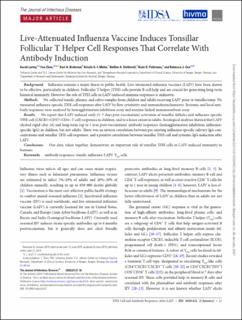Live-attenuated influenza vaccine induces tonsillar follicular T helper cell responses that correlate with antibody induction
Jalloh, Sarah Larteley Lartey; Zhou, Fan; Brokstad, Karl Albert; Mohn, Kristin Greve-Isdahl; Slettevoll, Steffen Aleksander; Pathirana, Rishi; Cox, Rebecca Jane
Journal article, Peer reviewed
Published version
Permanent lenke
https://hdl.handle.net/11250/2760650Utgivelsesdato
2020Metadata
Vis full innførselSamlinger
- Department of Clinical Science [2318]
- Registrations from Cristin [9791]
Sammendrag
Background: Influenza remains a major threat to public health. Live-attenuated influenza vaccines (LAIV) have been shown to be effective, particularly in children. Follicular T helper (TFH) cells provide B-cell help and are crucial for generating long-term humoral immunity. However the role of TFH cells in LAIV-induced immune responses is unknown.
Methods: We collected tonsils, plasma, and saliva samples from children and adults receiving LAIV prior to tonsillectomy. We measured influenza-specific TFH-cell responses after LAIV by flow cytometry and immunohistochemistry. Systemic and local antibody responses were analysed by hemagglutination inhibition assay and enzyme-linked immunosorbent assay.
Results: We report that LAIV induced early (3–7 days post-vaccination) activation of tonsillar follicles and influenza-specific TFH-cell (CXCR5+CD57+CD4+ T cell) responses in children, and to a lesser extent in adults. Serological analyses showed that LAIV elicited rapid (day 14) and long-term (up to 1 year post-vaccination) antibody responses (hemagglutination inhibition, influenza-specific IgG) in children, but not adults. There was an inverse correlation between pre-existing influenza-specific salivary IgA concentrations and tonsillar TFH-cell responses, and a positive correlation between tonsillar TFH-cell and systemic IgG induction after LAIV.
Conclusions: Our data, taken together, demonstrate an important role of tonsillar TFH cells in LAIV-induced immunity in humans.

